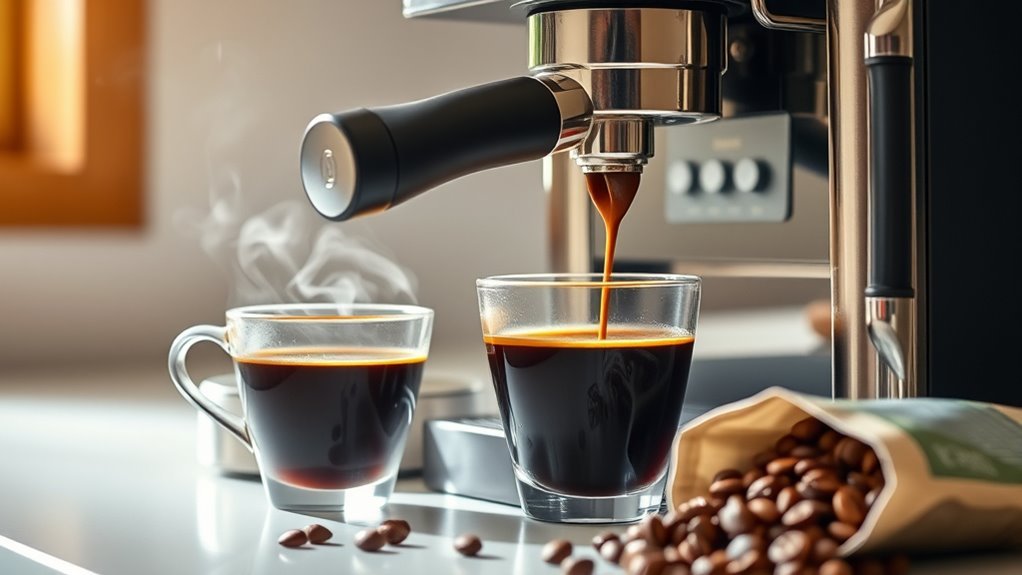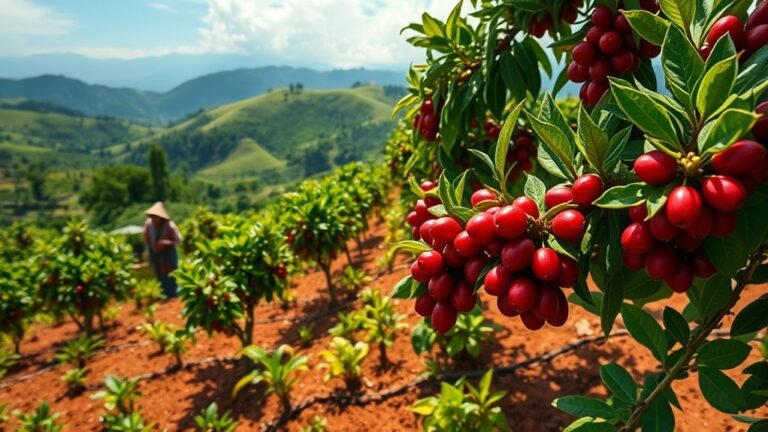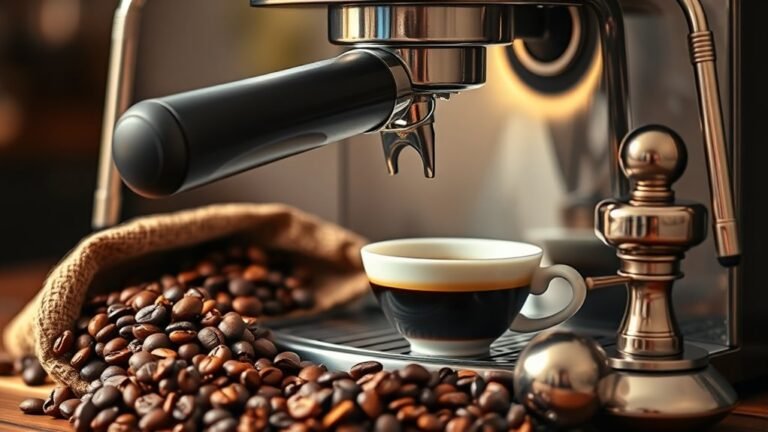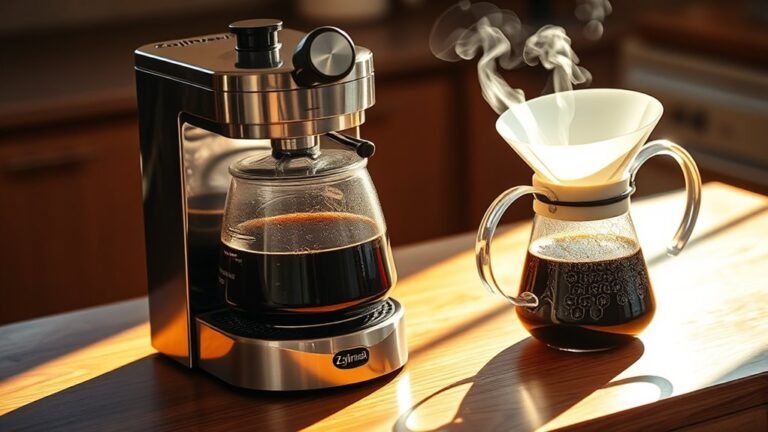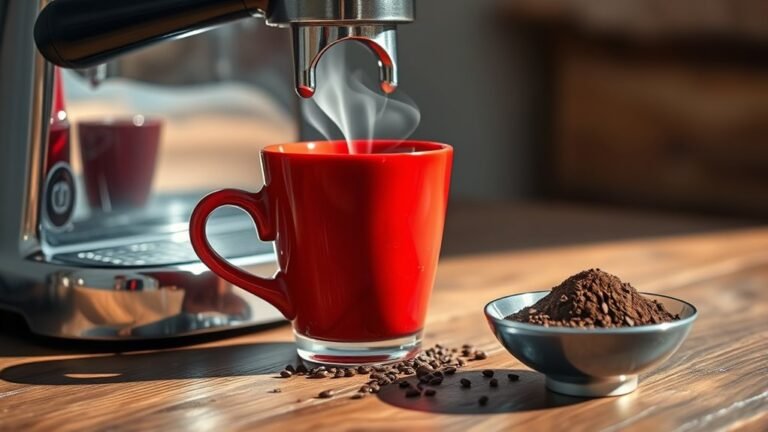Can Espresso Be Made in a Coffee Maker
You can’t effectively make espresso in a standard coffee maker. Espresso requires high pressure and finely ground coffee for its signature rich flavor and creamy consistency. Drip coffee makers rely on gravity to extract flavors, which doesn’t meet espresso’s unique brewing needs. If you want a stronger brew, consider adjusting grind sizes or using specific methods to mimic espresso. There’s more to explore about enhancing your coffee experience and what equipment is better suited for espresso.
Understanding Espresso and Its Characteristics
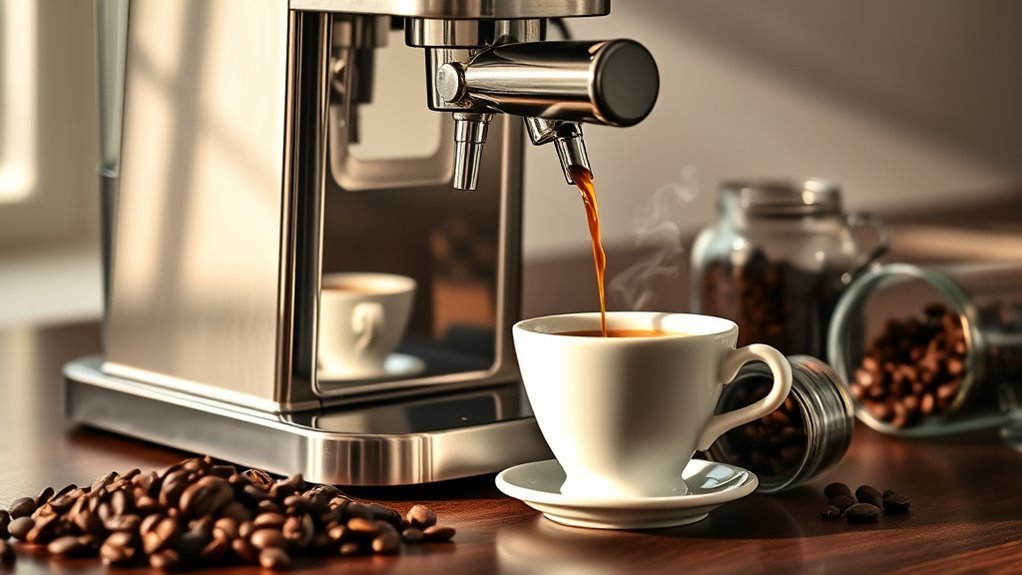
When you think about espresso, it’s essential to understand its unique characteristics that set it apart from regular coffee. Espresso is defined as a concentrated coffee brewed by forcing hot water through finely-ground coffee under high pressure. This method results in a rich, bold flavor and a creamy consistency, often topped with a layer of crema. The origins of espresso trace back to Italy in the early 20th century, where it revolutionized coffee-making techniques. Unlike standard brewing methods, espresso requires specific grind sizes, water temperature, and brewing time, which are vital for achieving its distinct taste profile. Understanding these elements not only enhances your appreciation of espresso but also empowers you to explore its versatility in various coffee beverages.
How a Drip Coffee Maker Works
A drip coffee maker brews coffee by heating water and allowing it to flow through coffee grounds, extracting flavors as it passes. The water temperature is essential; too hot or too cold can affect the extraction process and ultimately the taste of your coffee. Understanding this brewing process helps you appreciate the science behind your daily cup.
Brewing Process Explained
Drip coffee makers are among the most common brewing devices, renowned for their simplicity and efficiency. The brewing process begins when you add water to the reservoir. As the machine heats the water, it flows through a tube and drips over coffee grounds contained in a filter. This method extracts flavors and oils from the coffee, creating a brew. However, it’s important to understand coffee maker limitations; while they excel in making traditional coffee, they can’t replicate espresso extraction techniques. The pressure and precision required for espresso aren’t achievable in a drip coffee maker. Consequently, if you’re searching for a rich, concentrated shot of espresso, you’ll need a dedicated espresso machine to reveal that experience.
Water Temperature Importance
While brewing coffee, water temperature plays an essential role in flavor extraction. For ideal results, you need to maintain a water temperature between 195°F and 205°F. If the water’s too hot, it can lead to over-extraction, making your coffee bitter. Conversely, if it’s too cold, you won’t extract enough flavor, resulting in a weak brew. This balance is vital for achieving the right taste and aroma.
In a drip coffee maker, water temperature directly impacts brewing efficiency. A consistent temperature guarantees that the coffee grounds are evenly saturated, maximizing the extraction process. By paying attention to this detail, you can elevate your coffee experience and enjoy a richer, more flavorful cup. Remember, the right temperature is the key to brewing freedom.
The Differences Between Espresso and Drip Coffee
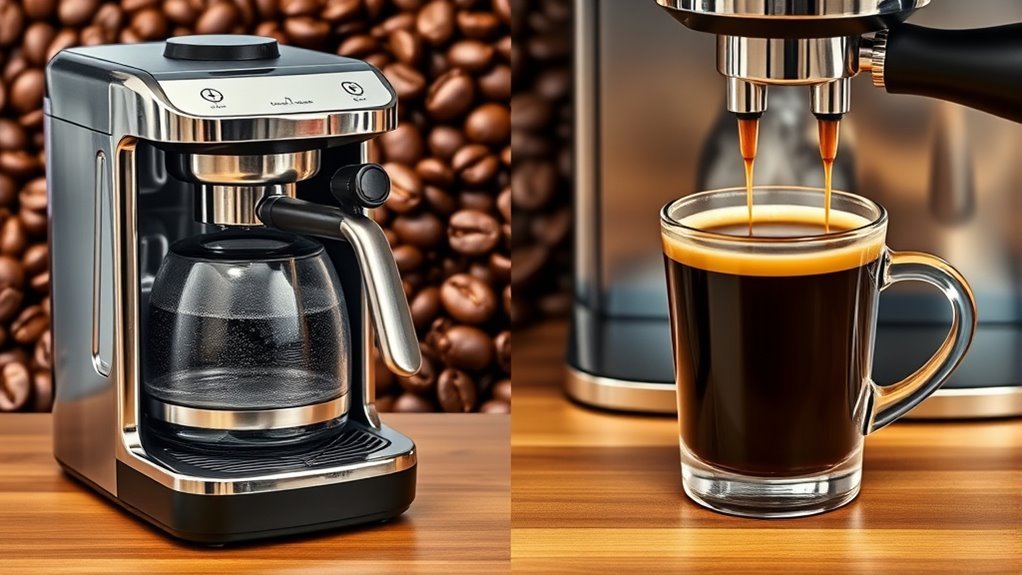
When you compare espresso and drip coffee, the differences in brewing methods become quite clear. Espresso is made under high pressure, resulting in a concentrated shot with rich flavors, while drip coffee relies on gravity to extract flavors gradually. This contrast not only affects the brewing process but also leads to distinct flavor profiles that cater to different preferences.
Brewing Methods Comparison
Although both espresso and drip coffee are popular brewing methods, they differ considerably in their preparation and flavor profiles. Understanding these differences can help you choose the best method for your taste.
- Brewing time: Espresso requires about 25-30 seconds, while drip coffee may take several minutes.
- Coffee extraction: Espresso uses high pressure for a concentrated shot, whereas drip coffee relies on gravity.
- Grind size: Espresso needs a fine grind, while drip coffee uses a coarser grind.
- Brewing equipment: Espresso machines are specialized, while drip coffee makers are more common.
- Espresso alternatives: Options like Aeropress or French press offer varied brewing experiences.
Flavor Profiles Explained
The differences in brewing methods not only impact the preparation but also greatly influence the flavor profiles of espresso and drip coffee. Espresso typically presents rich, concentrated flavors with bold tasting notes, often highlighting chocolate, caramel, or nutty undertones. The brewing pressure extracts oils and compounds, creating a thicker body and a creamy mouthfeel. In contrast, drip coffee offers a lighter, more nuanced experience, emphasizing brighter acidity and a wider range of aroma profiles. You’ll often detect floral or fruity notes in drip coffee, as the longer extraction time allows for more subtle flavors to emerge. Understanding these distinctions helps you appreciate the unique qualities each method brings to your cup, empowering you to choose according to your palate’s desires.
Choosing the Right Coffee Beans
Choosing the right coffee beans is essential for crafting a quality espresso, as different beans possess unique flavor profiles and characteristics that can greatly influence the final brew. You’ll want to contemplate both the bean origin and roast level when selecting your beans. Here are some key factors to keep in mind:
- Bean Origin: Different regions offer distinct flavors; for instance, Ethiopian beans are fruity, while Colombian beans are nutty.
- Roast Level: Light roasts maintain more acidity and brightness, while dark roasts provide deeper, bolder flavors.
- Freshness: Opt for freshly roasted beans to preserve flavor.
- Blend vs. Single Origin: Blends can offer complexity, while single origins highlight specific characteristics.
- Personal Preference: Ultimately, choose beans that align with your taste.
Adjusting Grind Size for Stronger Flavor
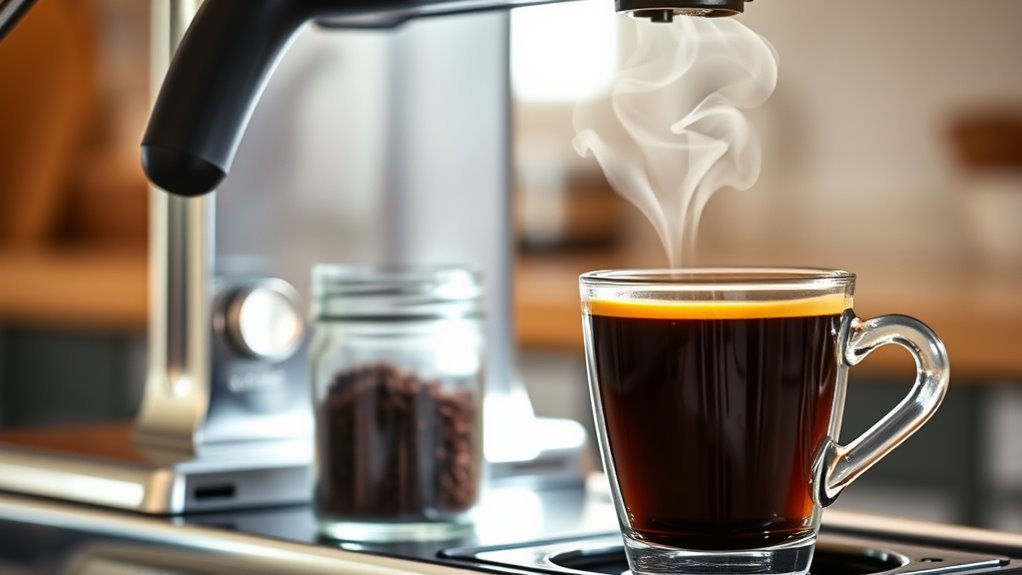
Adjusting the grind size of your coffee beans can greatly enhance the flavor profile of your espresso. A finer grind increases the surface area, allowing for better extraction of oils and flavors. However, it’s essential to maintain grind consistency to avoid uneven extraction, which can lead to bitterness or sourness. Here’s a quick reference table for ideal grind sizes and their effects on extraction time:
| Grind Size | Extraction Time | Flavor Profile |
|---|---|---|
| Coarse | 15-20 seconds | Under-extracted |
| Medium | 25-30 seconds | Balanced |
| Fine | 20-25 seconds | Rich, full-bodied |
| Extra Fine | 15 seconds | Over-extracted, bitter |
Experimenting with grind size lets you control the extraction time, ultimately leading to a more satisfying espresso experience.
Techniques for Brewing Espresso-Style Coffee
While many coffee enthusiasts believe that authentic espresso can only be made with an espresso machine, there are several techniques you can employ to brew espresso-style coffee using a standard coffee maker. By adjusting your methods, you can create espresso alternatives that pack a punch in coffee intensity. Here are some effective techniques:
Many believe espresso requires a machine, but you can brew espresso-style coffee at home with simple adjustments.
- Use a fine grind for maximum extraction.
- Increase the coffee-to-water ratio for stronger flavor.
- Brew at a higher temperature to enhance richness.
- Allow the coffee to steep longer for deeper extraction.
- Experiment with adding pressure by using a French press method.
These techniques can help you achieve a satisfying espresso-style coffee experience, even without the luxury of an espresso machine.
Enhancing Your Brew With Flavor Additions
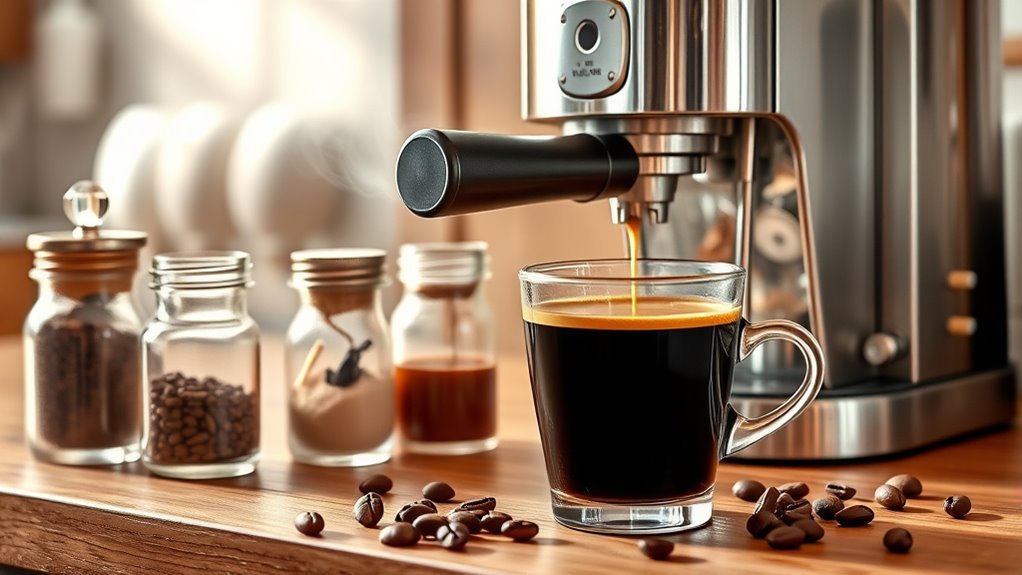
To elevate your espresso-style coffee, consider incorporating flavor additions that can enhance the overall experience. Flavor syrups are an excellent way to personalize your brew, allowing you to experiment with various tastes like vanilla, caramel, or hazelnut. Additionally, milk frothing can create a creamy texture, adding richness to your drink.
Here’s a quick guide to flavor additions:
| Flavor Addition | Suggested Use |
|---|---|
| Vanilla Syrup | Add 1-2 pumps for sweetness |
| Caramel Syrup | Drizzle on top for a treat |
| Hazelnut Syrup | Mix in for nutty flavor |
| Frothed Milk | Use in lattes or macchiatos |
With these enhancements, you’ll have a more enjoyable and tailored espresso-style coffee experience.
Common Mistakes to Avoid When Brewing Espresso in a Coffee Maker
When brewing espresso in a coffee maker, it’s crucial to recognize and avoid common pitfalls that can compromise the quality of your beverage. The right brewing techniques can make all the difference, so keep these mistakes in mind:
- Using the wrong grind size: A coarse grind won’t extract properly, while a fine grind can lead to bitterness.
- Incorrect water temperature: Too hot or too cold water can ruin the extraction process.
- Neglecting the coffee-to-water ratio: Improper proportions can result in weak or overly strong espresso.
- Not preheating your coffee maker: Skipping this step can lead to inconsistent brewing temperatures.
- Ignoring cleanliness: Residue builds up over time, affecting the flavor of your espresso.
Avoiding these mistakes will help you brew a satisfying cup every time.
Frequently Asked Questions
Can Any Coffee Maker Brew Espresso-Style Coffee?
When considering if any coffee maker can brew espresso-style coffee, you need to focus on espresso extraction. Traditional coffee makers typically don’t reach the necessary pressure to achieve that rich, concentrated flavor. However, some machines, like certain stovetop Moka pots or specialized espresso machines, can mimic that extraction process. If you’re after that bold taste, look for coffee brewing equipment specifically designed for espresso to guarantee you’re getting the experience you desire.
What Is the Ideal Water Temperature for Brewing Espresso?
The ideal water temperature for brewing espresso is typically between 190°F and 205°F (88°C to 96°C). Staying within this range guarantees maximum extraction of flavors and aromas, enhancing the coffee’s richness. If you’re using various brewing techniques, slight adjustments might be needed, but consistently hitting this temperature range will yield the best results. Remember, too hot can scorch the grounds, while too cool can lead to under-extraction, so find that sweet spot!
How Long Should Espresso Brew in a Coffee Maker?
When it comes to espresso, brewing time plays a vital role in determining coffee strength. Ideally, you should aim for a brewing time of 25 to 30 seconds. This duration allows the flavors to extract properly, resulting in a rich and balanced shot. If you brew for too long, you might end up with a bitter taste; if too short, the coffee can be weak and underwhelming. Finding that sweet spot is essential for a satisfying espresso experience.
Can I Use Espresso Pods in a Regular Coffee Maker?
You might wonder if you can use espresso pods in a regular coffee maker. Generally, espresso pod compatibility depends on your machine’s design. Most standard coffee makers aren’t equipped to handle the pressure needed for brewing espresso, which means you might not get the rich flavor you expect. If you’re looking for freedom in brewing, consider investing in a dedicated espresso machine, as it’ll allow you to enjoy espresso properly without limitations.
What Type of Coffee Maker Is Best for Espresso?
Did you know that over 60% of coffee drinkers prefer espresso for its bold flavor? If you’re looking for the best coffee maker for espresso, consider a manual espresso machine. These machines give you complete control over the brewing process, allowing you to experiment with grind size and pressure. While automatic machines are convenient, manual options can enhance your coffee-making experience, offering a deeper appreciation for each shot you pull.
